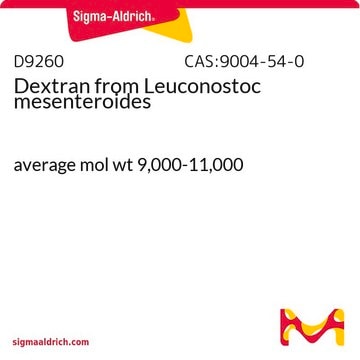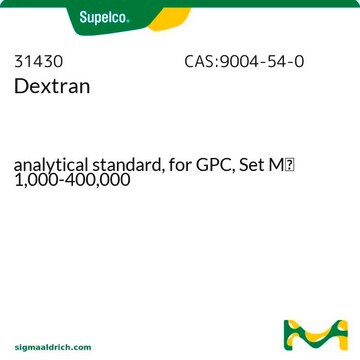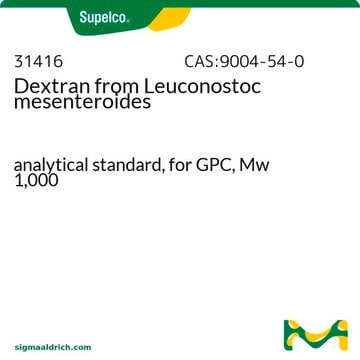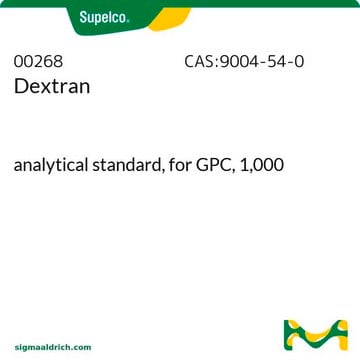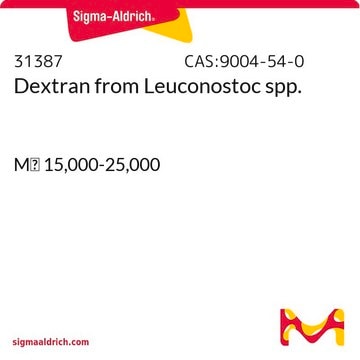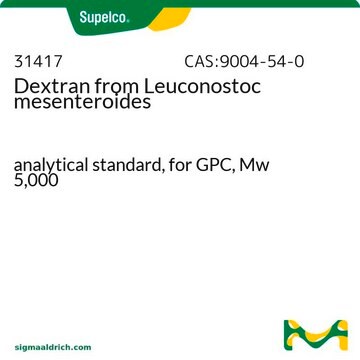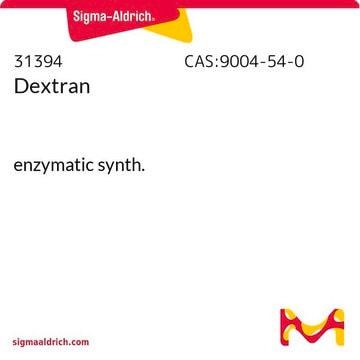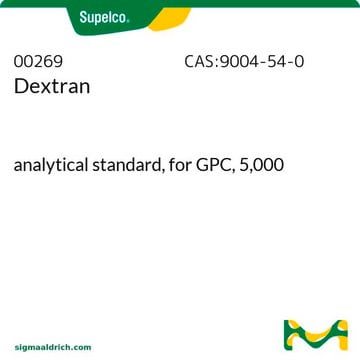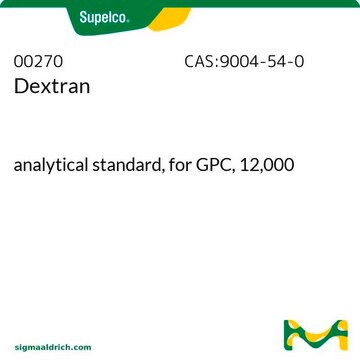All Photos(3)
About This Item
Linear Formula:
(C6H10O5)n
CAS Number:
EC Number:
MDL number:
UNSPSC Code:
12352201
NACRES:
NA.25
Recommended Products
biological source
(Leuconostoc spp)
form
powder
mol wt
Mr ~6,000
color
white
mp
483 °C ((901 °F ))
solubility
water: 1.5 g/10 mL, colorless to faintly yellow
storage temp.
room temp
SMILES string
O1C(C(C(C(C1CO)O)O)O)OCC2OC(C(C(C2O)O)O)OCC(O)C(O)C(O)C(O)C=O
InChI
1S/C18H32O16/c19-1-5(21)9(23)10(24)6(22)3-31-17-16(30)14(28)12(26)8(34-17)4-32-18-15(29)13(27)11(25)7(2-20)33-18/h1,5-18,20-30H,2-4H2
InChI key
FZWBNHMXJMCXLU-UHFFFAOYSA-N
Looking for similar products? Visit Product Comparison Guide
General description
Dextran is a branched glucan composed of linear α(1→6) linked glucose units and α (1→3) link initiated branches. Dextran ranges in size from 10,000 to 150,000 Kd. Dextrans are used in many applications as volume extenders, stabilizers, matrix components, binding platforms, lubricants and physical structure components. Low molecular weight dextrans are often preferred versus high molecular weight dextrans due to their different viscosities, aggregation and permeation properties.
Dextran is an extracellular bacterial polymer of D-glucopyranose. It mostly comprises α-(1→6) linkage in the main chain and a variable number of α-(1→2), α-(1→3), α-(1→4) branched linkages.
Application
Dextran from Leuconostoc spp. has been used:
- for the glycation of caseinate to investigate the influence of an increase in carbohydrate chain length compared to glucose
- for the mass calibration of matrix-assisted laser desorption ionization-time of flight mass spectroscopy (MALDI-TOF) for the characterization of silver nanoparticles (AgNPs)
- as a non-toxic stabilizer to assess the in vivo administration of tungsten trioxide(WO3) nanoparticles
Biochem/physiol Actions
Dextran is used as a drug, particularly as a blood plasma volume expander. It is also useful as an adjuvant, emulsifier, carrier, and stabilizer in the food, pharmaceutical, and chemical industries. Sephadex is a cross-linked dextran that is commonly used for the separation and purification of protein. In the food industry, dextran is applicable as a thickener for jam and ice cream. It hinders the crystallization of sugar and augments moisture retention. This preserves the flavor and appearance of several food items.
Other Notes
To gain a comprehensive understanding of our extensive range of Dextrans for your research, we encourage you to visit our Carbohydrates Category page.
Storage Class Code
11 - Combustible Solids
WGK
WGK 2
Personal Protective Equipment
dust mask type N95 (US), Eyeshields, Gloves
Choose from one of the most recent versions:
Already Own This Product?
Find documentation for the products that you have recently purchased in the Document Library.
Customers Also Viewed
Eugen Sisu et al.
Rapid communications in mass spectrometry : RCM, 20(2), 209-218 (2005-12-15)
A combined methodology for obtaining at the preparative scale and characterization by nanoelectrospray ionization (nanoESI) quadrupole time-of-flight (QTOF) mass spectrometry (MS) and tandem MS (MS/MS) of linear polysaccharides modified at the reducing end is presented. Two polydisperse maltodextrins (1000 and
Thomas Rath et al.
Nephron. Clinical practice, 114(1), c81-c88 (2009-11-06)
Intravenous iron supplementation is a basic principle in the therapy of haemodialysis (HD) patients with renal anaemia. In the Iron Dextran in Renal Anaemia (IDIRA) study, we analysed the efficacy of a therapy with low-molecular-weight iron dextran (LMW-ID) in stable
R J Stenekes et al.
Biomaterials, 22(13), 1891-1898 (2001-06-09)
In this paper, a novel method is presented for the preparation of dextran hydrogels and microspheres, based on crystallization. Although dextrans are known to be well soluble in water, precipitation was observed in concentrated aqueous solutions of low molecular weight
Rohan P Choraghe et al.
Life (Basel, Switzerland), 11(2) (2021-02-13)
At host-pathogen contact sites with Candida albicans, Dectin-1 activates pro-inflammatory signaling, while DC-SIGN promotes adhesion to the fungal surface. We observed that Dectin-1 and DC-SIGN collaborate to enhance capture/retention of C. albicans under fluid shear culture conditions. Therefore, we devised
Molecular Weight Effects on the Miscibility Behavior of Dextran and Maltodextrin with Poly(vinylpyrrolidone).
Van Eerdenbrugh B, Taylor LS.
Pharmaceut. Res., doi: 10-doi: 10 (2012)
Our team of scientists has experience in all areas of research including Life Science, Material Science, Chemical Synthesis, Chromatography, Analytical and many others.
Contact Technical Service
